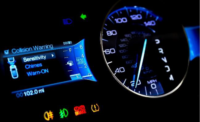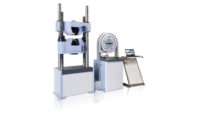The field of mechatronics in automotive engineering refers to a combinatorial approach to design, with emphasis on contributions from mechanical, electrical, computer, and control engineering groups.
As manufacturers of passenger vehicles seek opportunities to differentiate their offerings, design teams collaborate on novel uses of emerging technology to address elements of consumer demand.
Sophisticated driver support systems that deliver safety and performance enhancements have emerged from such collaborations. Assuring quality and performance in such systems is mandatory, especially in those that involve safety enhancing devices.
Systems based on mechatronics use microelectronic mechanical sensors (MEMS) to pick up signals from the environment, process them to generate output signals, and transform those output signals into forces, motions, and actions.
Examples of mechatronic systems include digitally-controlled combustion engines, self-adaptive machine tools, and contact-free magnetic bearings. Advanced control capabilities resulting from close integration of mechanical systems with sensors and microprocessors are among the most important aspects of mechatronics.
Interdisciplinary in nature, mechatronics requires input and coordination of design elements with control electronics and embedded software as integral components. Embedded software is so crucial to the functionality of mechatronics-based systems that it is typically referred to as a “machine element.”
Anti-lock brake systems (ABS) are a common example of mechatronics used in most passenger vehicles. ABS systems allow the wheels of a vehicle to maintain traction on the road surface while braking. ABS can prevent the wheels of the vehicle from locking up, which can cause skidding and subsequent loss of control. Since their initial widespread use in production cars, anti-lock braking systems have evolved considerably.
Recent versions of the ABS concept not only prevent wheel lock under braking, but also electronically control the front-to-rear brake bias. This function, depending on its specific capabilities and implementation, is known as electronic brake force distribution or electronic stability control.
Stability control systems utilize additional angle and gyroscopic sensors that measure steering wheel angle and the direction in which the vehicle is pointed. When the angle of the wheel does not coincide with the direction of the vehicle, the software controlling the system will activate the brakes on the necessary individual wheels so that the vehicle travels in the direction which it is being steered. The steering wheel sensor can also provide input to help increase braking power on curves by sending signals to increase braking force on the inside wheels.
The most sophisticated of these systems incorporate a range of other sensors that can be utilized to gather inputs on road conditions and proximity to other vehicles and objects. These sensors can be integrated with mechanical control systems to provide automatic braking and throttle control capabilities.
Tire pressure monitoring systems represent an example for automotive technology driving MEMS technology. TPMS could be mandatory in European vehicles soon. Putting the pressure sensor into the tire instead of the rim supports additional measurements such as the tire’s contact to the street. In such an intelligent TPMS, MEMS could also serve as energy harvesters that could replace the battery. At least two companies are reportedly working on such an ‘intelligent tire’.
Electronics and systems based on mechatronics are among the principal drivers of innovation in passenger vehicles and the value they contribute represents substantial advancements in safety as well as performance. Unfortunately, they also occupy a leading position in failure statistics. The greatest challenge is therefore to master the ever-rising levels of complexity while achieving zero-error production and structural durability over the entire performance range while continuing the integration of new features. For this reason, the goal of mechanical testing in this field is to ensure safety, elevate production quality, and increase structural durability.
Examples of mechatronics systems that benefit from mechanical testing are solenoid switches and electromechanical actuators which must perform specific actions in an emergency, as well as pre-crash active safety elements such as seat belt tensioners and head-rest positioning systems, according to Aleksander Koprivc, automotive industry manager for Zwick/Roell, a leading international supplier of material and component test systems to the global automotive industry.
Zwick provides unique mechatronic testing solutions that are the result of experience in handling both test specimens and components with complex geometry down to tens of millimeters in size. The flexible design of Zwick equipment can accommodate a variety of tests and can be easily configured for new tests, he said.
“Generally manufacturers and suppliers alike seek supreme measurement accuracy, ease of use, and the seamless integration of the testing system into their respective information technology environments,” he said.
In mechatronics applications, Zwick solutions can measure classical characteristics of force, displacement, and time in relation to electrical signals (digital or analog). Also possible is the opposite, where the element is triggered with a signal and the Zwick machine is used to measure the reaction of the system, he said.
Advanced mechatronic systems are found primarily in premium cars where volume levels are lower yet consumer demand for performance tends to be more stringent. When accuracy requirements coincide with the need to certify performance within a tight range of tolerances, it could make sense to consider implementation of a robotized testing system, Koprivc said.
The need for testing efficiency is driven by the relationship between OEM and supplier, where increasingly, testing responsibility is shifting to the supplier. In cases where OEMs specifically prescribe the tests to be conducted and tolerances that are acceptable, there are clear protocols suppliers may follow. In many cases, however, this level of detail is not defined and the potential for errors in testing increases.
According to Koprivc, a way to overcome this could be that OEMs set specific testing criteria, including defining the elements of an automated test system to eliminate the source of potential errors resulting from operator influence. Once defined, the automated test system would be implemented across that particular OEM’s supplier network.
Testing Electronic Switches and Buttons
To determine the switching characteristics of electronic switches and switching elements, the electrical signal of the assembly under test is integrated into Zwick’s testControl electronics. The testXpert® II measurement and control software assigns the electrical switching contacts synchronously to the relevant load and deformation data. In a hysteresis test (switching on and off), the mechanical load and/or the torque and the electrical switching points are determined and displayed. For torque measurement, the test machine is additionally equipped with a torsion drive and sensors.
Zwick’s PrecisionLine product suite is ideal for applications involving extremely small strains with elevated requirements for accuracy. An example may be found in the testing of small compression springs for electromechanical components such as airbag deployment systems.
The single-column zwicki-Line testing machine was specially designed for mechanical testing applications involving low test-loads. The platform incorporates a space-saving design that conserves lab space without sacrificing accuracy. It is used for tensile, compression, flexure and torsion tests. The zwicki-Line range of test systems is particularly suitable for production monitoring, goods inwards checks, and for reliable quality assurance testing.
Ergonomics and Safety
Within the automotive industry, quality initiatives focused on in-cabin ergonomics, particularly within the premium and luxury class passenger vehicle segments, are contributing to growth in automated testing systems. The sensitivity that such applications demand offers one explanation for rising demand while the attractiveness of continuous operation also presents a compelling value proposition.
Haptics, a field that involves connecting human touch with the functionality of electronics, is central to touchscreen-based navigation systems that are now ubiquitous in passenger vehicles. Haptic feedback incorporates polymers and micro-electrical-mechanical systems (MEMS) working in concert to produce interaction that is based on touch. As applications for haptics-based devices offer increasingly complex levels of interaction, consumers require that products keep pace. Suppliers of haptics technology systems utilize electroactive polymers which change size or shape when stimulated by an electric field. This process converts polymers into actuators that support force feedback and stimulate interaction with the touchscreen that serves as the interface for vehicle navigation systems, handless communication devices, and sound systems within the dashboard console.
Manufacturers of premium and luxury vehicles continue to demonstrate interest in evaluating ergonomic viability of dashboard functions such as the navigation system. Measurements of the force required to engage the system are among the properties of interest for design teams as well as quality managers. Additional applications that involve ergonomics are torsion tests that evaluate the torsional resistance of knobs that control airflow to the passenger cabin as well as fixtures that control volume on the sound system.
Such attention to detail confirms the emphasis that both manufacturers and suppliers place on safety, Koprivc said.
“Knobs and buttons must be easy to engage and operate, but also sturdy enough to remain in the desired position. The correct quotient across these criteria enables drivers to make adjustments without sacrificing safety,” explained Koprivc.
Function-Testing of Electromagnetic Actuators
Demand for enhanced levels of comfort and performance has driven manufacturers to introduce advanced suspension systems that offer smooth, consistent ride quality. Solenoid valves are at the core of air suspension systems. Consisting of a helical coil wrapped around a metallic core, solenoids produce a uniform magnetic field when a current is passed through the assembly. As actuators in air suspension systems, solenoids utilize the magnetic field to apply force sufficient to open a valve that controls air flow. As a result, establishing a thorough understanding of solenoid mechanical performance is crucial to the delivery of precision in these systems.
Examining the load-travel characteristic curve of solenoids and proportional magnets effectively provides a function test for electromagnetic actuators and is used mainly for final inspections. This curve allows the principal operating characteristics to be identified, while the load-force curve shows whether the actuator is applying the required force within its operating range at a fixed current level. The hysteresis provides information about friction resulting from the quality of the mechanical parts.
The load-current curve is primarily checked in connection with proportional magnets to establish whether the actuator applies the necessary force within a current range at a defined armature position. The ideal curve is a linear relationship between load and current around the operating point.
Zwick offers a comprehensive range of test machines, based on standard components, for testing solenoid actuators for product design processes and in support of quality control initiatives.



